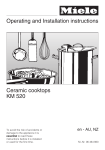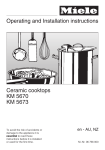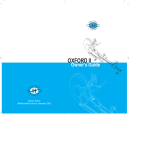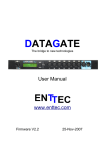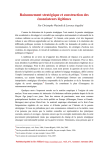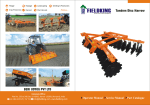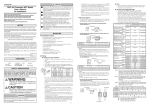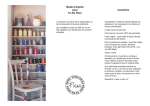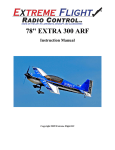Download Pdf Manual - Twisted Hobbys
Transcript
mini CRACK PITTS Specifications Wing span – 22” AUW 100g – 115g 2000-2400kV motor (12g – 16g) 6 - 10 amp ESC 2s/3s - 240/340mAh battery 4 ch radio 2x 3.5g to 4.5g servos 1x 5.0g to 7.0g aileron servo 6x3 to 7x3.5 prop USA Distributor Twisted Hobbys www.twistedhobbys.com Rev: 2013.05.31.v001d 1 TABLE OF CONTENTS Page WARNING INFORMATION ........................................................................................................................................................ 3 SHIPPING DAMAGE..................................................................................................................................................................... 3 OUR MISSION ................................................................................................................................................................................ 3 SAFETY NOTES ............................................................................................................................................................................. 4 IMPORTANT: PRIOR TO ANY ASSEMBLY.................................................................................................................... 4 KIT CONTENTS ............................................................................................................................................................................. 5 OPTIONAL PARTS ........................................................................................................................................................................ 6 TOOLS & ADHESIVES NEEDED ............................................................................................................................................... 7 THE BUILD ..................................................................................................................................................................................... 8 CENTER OF GRAVITY .............................................................................................................................................................. 45 CONTROL THROWS .................................................................................................................................................................. 46 Extreme & 3D Beginner & Sport EXTREME & 3D SET UP PRECAUTIONS 46 46 46 PRE-FLIGHT & TESTING ......................................................................................................................................................... 47 PREFLIGHT CHECKS Motor Flight Controls Batteries Radio Range Check FLIGHT T ESTING STORAGE 47 47 47 47 47 47 47 47 NOTES & S/U SHEET .................................................................................................................................................................. 48 TIPS AND TRICKS....................................................................................................................................................................... 49 RC FACTORY DIAGRAMS........................................................................................................................................................ 50 Rev: 2013.05.31.v001d 2 TWISTED HOBBYS Website: www.twistedhobbys.com – email: [email protected] Thank you for your purchasing a Twisted Hobbys’ model. Please read through the entire manual before beginning to build this model. If you have any questions please contact us at the above indicated email address. WARNING INFORMATION This R/C Aircraft is not a toy! Read and understand the entire manual before assembly. If misused, it can cause serious bodily harm and property damage. Fly only in open areas, and AMA (Academy of Model Aeronautics) approved flying sites. Do not over look the warnings and instructions enclosed or those provided by other manufactures’ products. If you are not an experienced pilot and airplane modeler you must use the help of an experienced pilot or an authorized flight instructor for the building and flying of this model aircraft. These instructions are suggestions only on how to assemble this model. There are other ways and methods to do so. Twisted Hobbys has no control over the final assembly, the materials and accessories used when assembling this kit, or the manner in which the assembled model, installed radio gear and electronic parts are used and maintained. Thus, no liability is assumed or accepted for any damage resulting from the use of the assembled model aircraft or from this instruction manual including but not limited to direct, indirect, incidental, special, and consequential damages. By the act of using this user-assembled product, the user accepts all resulting liability. In no event shall Twisted Hobbys’ liability exceed the original purchase price of the kit. SHIPPING DAMAGE Twisted Hobbys checks each plane before shipping to ensure that each kit is in fine condition. We have no bearing on the condition of any component parts damaged by use, modification, or assembly of the model. Inspect the components of this kit upon receipt. If you find any parts damaged or missing, contact Twisted Hobbys immediately. We will not accept the return or replacement of parts on which assembly work has already begun. Twisted Hobbys reserves the right to change this warranty at anytime without notice. OUR MISSION To provide the best products and service to our customers at the lowest prices possible. We take great pride in our company, our commitment to customer service and in the products we sell. Our online store is designed to provide you with a safe and secure environment to browse our product catalog. Thank you for shopping with Twisted Hobbys! Rev: 2013.05.31.v001d 3 SAFETY NOTES Before assembling and flying this model, read carefully any instructions and warnings of other manufacturers for all the products you installed or used on your model, especially radio equipment and power source. Check thoroughly before every flight that the airplanes’ components are in good shape and functioning properly. If you find a fault do not fly the model until you have corrected the problem. Radio interference caused by unknown sources can occur at any time without notice. In such a case, your model will be uncontrollable and completely unpredictable. Make sure to perform a range check before every flight. If you detect a control problem or interference during a flight, immediately land the model to prevent a potential accident. Youngsters should only be allowed to assemble and fly these models under the instruction and supervision of an experienced adult. Do not operate this model in a confined area. Do not stand in line with, or in front of a spinning propeller and never touch it with any object. IMPORTANT: PRIOR TO ANY ASSEMBLY Please Note: after removing kit from shipping box, lay each piece flat on a hard surface, this will allow the airframe to straighten out if lightly bent from shipping. Do not worry since EPP is very pliable and can be bent back if out of shape. Rev: 2013.05.31.v001d 4 kit contents PARTS LIST AIRFRAME COMPONENTS 1x 1x 1x 1x 1x 1x 1x 2x Top Wing Bottom wing Fuselage Vertical Fuselage Horizontal Canopy Rudder Elevator Wheel Pants Rev: 2013.05.31.v001d 2x 4x 4x 2x 4x Landing Gear Fairing Inboard SFGs Outboard SFGs Wing Truss 0.50mm x 3.0mm x 500mm Carbon Rect. (Wing Spars) 2x 0.75mm Dia x 330mm long Carbon Rod (Tail Push Rods) 1x Hardware Pack (see detail) DETAIL - HARDWARE HARDWARE PACK PAC K 1x 3mm Dia x 67mm Shrink Tube 1x Plastic Parts Kit 2x .75mm Dia x 120mm Carbon Rod (aileron couplers) 1x .5mm x 3mm x 100mm Carbon Rect (elevator) 2x .5mm x 3mm x 150mm Carbon Rect (landing gear) 1x Wood Parts Kit 2x .75mm Dia x 70 mm Carbon Rod (aileron servo) 2x .5mm x 3mm x 70mm Carbon Rect (front fuse.) 4x .5mm x 3mm x 110mm Carbon Rect (truss & fuse.) 14x Snap Rod End Links 5 OPTIONAL PARTS Power Combo Kit (Matched by Twisted Hobbys) (1) 14g 2300kv Crack Series Motor (1) Twisted Hobbys 6A ESC (2) 3.5g Digital Servo (1) 7.0g Digital Servo (1) 7x3.5 Prop Perfect choice for building and repairing your Twisted Hobbys EPP planes! This is the only adhesive you will ever need. Welder virtually bonds anything to anything! Clear, heavy-duty, flexible and water-proof when dry. Use indoors or out. (1) 1 oz tube Specifications CA and Kicker 6 Channel / DSM2 / 2.4GHZ 25mm X 19mm X 11mm Weight: 3.0g / Input: 3.5–9.6V Bind plug included Various thickness CA glues and Activator available from Twisted Hobbys’ Rev: 2013.05.31.v001d Blenderm tape is one of the best know tapes used for hinging and repairing your Depron or Epp models. Each 3M Blenderm key features are its high strength adhesive, extremely flexible and long lasting. Each roll consists of 1/2" wide x 4m in length Note: many of these “optional parts” shown or similar items, may be available from the Twisted Hobbys’ web store. 6 Tools & Adhesives Needed • Tape Measure and Ruler • Lighter • Small drill bits • Welders Glue • Hobby Knife w/new Blade Blade • Needle Nose Pliers • Wire Cutters • Low Temp Hot Glue Gun Tools shown and listed are suggestions only. Depending on your building technique you may not need everything indicated – and/or – you may find that other tools available to yourself may be of benefit, to your Build. It is also recommended that you have a flat building surface, one that will accept stick pins and push pins. An Acrostic Ceiling panel from you local hardware store fits this bill nicely, and will lay flat on your work table. Over size / long push pins are available at your local craft store. These two items are by no means required, but will aid in the building process, and can be used for future projects. Rev: 2013.05.31.v001d • Course Sand Paper • Scissors • Small Phillips Screw Driver • CA and Applicator Applicator Tips • Activator Activator 7 THE BUILD CONSTRUCTION METHODS: Building surface should be at least 2ft x 4ft and flat. Weights or some small heavy objects will be handy for holding things in place during the time glue is setting. Welders glue is the primary adhesive used for this build. The Rod Guides and Snap-In End Links use thin CA with Applicator and Activator. When using the Welders glue for a butt joint, joint, apply a thin film to each surface, surface, allow to sit for approx five minutes minutes and then assemble. assemble. Note that this method will create a nearly instant bond, so locate carefully when bringing the two pieces together. If alignment is necessary or a slip joint, do not allow the glue to tack up, simple apply and join immediately, you will have several minutes to locate the two parts before the glue sets up. In most cases the parts being glued can be handled with care in 30 minutes, full cure is approx 24 hours. Open up you kit and inspect for damage and / or missing parts. Use the Parts List on page 5 to verify that your kit is complete. Rev: 2013.05.31.v001d Do the same with the Power Set, confirm that you have all your items and that they appear to be in sound condition. Testing of functionality will be one of the first steps that will follow shortly. 8 To loosen up the hinged areas, locate the control surface parts that have hinges attached, fold the control surfaces back onto them selves and let sit like this until they move freely. Make a new program in your Radio. Zero all the Trims and Subtrims. For starters all the ATV can be set to 100%. Adjustment of additional setting will be done at the end of the build. Compare your Reciever to the included diagram from the side as shown above. Make a note of the polarity of the pins. In most cases, either Black or Brown is used to identify Negative (-). Identify the porper pins for the; Throttle, Aileron, Elevator and Rudder Channels. Carefully compare to the diagram to make sure you have the correct orientations. Plug Motor wires into the ESC, the ESC into the Throttle Channel, the larger servo into the Aileron Channel, and the two smaller servos into the Elevator and Rudder Channels. Bind per your Radio’s Instructions. Program the Throttle End Points per the ESC Instructions and next couple steps…. Rev: 2013.05.31.v001d 9 … turn off your Transmitter and unplug the flight battery from the ESC…. … position the Throttle Stick to full HIGH postion and power on the radio… …. reconnect the battery to the ESC and listen for two quick short beeps, immediately following the beeps, move the Throttle stick to low position. Next you should hear a series of tones to indicate that programing is complete. Re-bind the system and double check correct operation of all components. Center all servos as close to 90 deg as possible. Install the Longest single arms on the small servos, and the double side horn onto the ailerion servo. Construction will start with installing the cabon spars into the Wings, Elevator and Vertical Wing Trusses. Locate all the parts as shown, taking care to match up the right length spar with the appropriate slot or marked area. Prep the slots in the Vertical Trusses and test fit the spars. Use a single 110mm Carbon Rectangle in each Truss. Rev: 2013.05.31.v001d 10 Cut all the way thru, and test fit the spar in insure the slit is long enough. Apply a small bead of Welders into the slot in the foam piece. Apply a thin coat of Welders to both sides of the spar. While spreading the foam a little, install the spar into the slot in the Truss. The spar is approx the same thickness as the foam, make sure it is fully installed Wipe off any excess Welders with a fresh piece of paper towel. Press the foam against the center spar area. Use some tape, stick pins or weight to help hold in postion while drying… Repeat for the other side. Rev: 2013.05.31.v001d 11 On the top side of the Elevator, there should be a shallow mark indicating where the Elevator spar is to be located. It may be necessary to hold it up to a light source in order to spot it. Locate the 100mm long rectangle spar. Cut a slit all the way through the Elevator, using the shallow mark as a guide for your strainght edge and hobby knife to follow. Test fit the spar to verify that you have cut your slit long enough. Note – spar will be installed in the middle of the foam thickness. Remove the spar, apply a small bead of Welder into the slot and re-install the spar, locate approx half way inbetween the foam thickness. Wipe off any extra glue. Using weights, tape or stick pins to apply a little pressure against the spar and sit the aside to dry. Rev: 2013.05.31.v001d 12 Next are the spars in the upper and lower wings. NOTE – these spars get “stacked” edge to edge inside the wing, so that together the width of the spar is the same as the foam of the wing. Locate the partial slit in the wing…. …. and with a long striaght edge and sharp hobby knife, cut the spar slit completely through the wing. When finished, the wing should still be in one piece, but open in the middle as shown to accept the spars Locate one of the four longest Carbon Rectangle spars (500mm in length) and test fit into the slot you just made. Apply a thin bead of Welders into the slot, but only about one inch from either end, leave the rest free of glue. Apply a Medium bead of Welders to the spar, leaveing about an inch from the ends free of glue, giving you a place to handle the spar from, the ends will get their glue from the previous step. Rev: 2013.05.31.v001d 13 While slightly spreading the wing, around the slit area, lay in the spar. Note – this spar will end up flush with the under side of the wing. OPTIONAL: OPTIONAL spars can be “spot” glued together prior to installing into the wing. Using a small screw driver or other similar device, push the spar all the way in until flush with the far side. Coat the second spar with Welders like was done with the first one, and “stack” this one onto of the one just installed. Make sure they are edge to edge and not over lapping. Once satisfied with the spars being correctly installed, secure the wing with some tape, weights or stick pins to keep a little pressure on the glue joint. Wipe away any extra glue. Repeat for the other Wing Locate the vertical fuselage piece and the black canopy foam piece. Apply a thin film of Welder to the mating surface of the Canopy piece. NOTE – this piece is going to get glued on with the “Tack” Method. Rev: 2013.05.31.v001d 14 Apply a thin layer of Welders to the fuselage side of where the conopy meets up. Let this piece and the one from the prevouse step “tack” up for about five or ten minutes. Once the two pieces are tacked up, bring them together. NOTE – the black piece is not as thick as the fuselage and should be “centered” when attaching to the fuselage. Locate the Aileron Gang horns from the plastice hardware kit, there should be four of them. Test fit the part into the provide slot on the Wing. Apply a small bead of Welders into the slot as shown. Apply a thin layer of Welders to the horn. Rev: 2013.05.31.v001d 15 Install the gang horn into the Wing. Use the edge of the plastic kit as a guide to help get the end of the horn perfectly aligned with the trailing edge. Wipe off any excess Welders Secure with a stick pin, tape or weight and allow to dry. Repeat for the other three aileron gang horns. Locate the Horizontal Fuselage section and the Elevator. Note that the pieces are “keyed” to insure proper alignment…. Bottom view shown above. Apply a thin layer of Welders to the Fuselage. Apply a thin layer of Welders to the Elevator section… Allow both pieces to tack up. Rev: 2013.05.31.v001d 16 Once the glue has tacked up, bring the two pieces together using the keyed features in the foam as a guide for proper alignment Next, prepare the Vertical Fuselage piece for assembly. It will need to be split into two pieces. Cut the Center tabs in half, using the small notch in them as a guide. Seperated and ready for the next assembly step. Remove the Tail Skid part from the back of the upper airframe piece. Fuselage assembly will start with the lower vertical piece and the horizontal fuse/elevator assembly. Apply a medium bead of Welders to the mating surfaces on the horizontal fuselage piece. Make sure that you are working on the under side. Rev: 2013.05.31.v001d 17 Apply a medium bead of Welders to the Vertical Fuselage section. Bring the two piece together, make sure they nose pieces line up flush and square to each other. This is where the motor mount will attach. Check for flushness and squareness in the horizontal direction as well. Once satisfied with the nose area, check for squareness alone the length of the fueselage. Tweak as required until square from nose to tail. Set aside with some weights and let dry. While the Fuselage is drying, the aileron control horns can be installed. Rev: 2013.05.31.v001d 18 The aileron horns are the ones with the square holes. Clean up the exsisting slot so that it goes all the way thru to the top side of the wing. Control Horn will install from the top side of the bottom wing as shown. Squeeze a small bead of Welders into the slot. Apply a thin coat of Welders to each side of the horn, in the area that will be captivated by the foam. Locate the horn so that it is flush with the bottom side, and so that its profile is even with hinged area as shown. Rev: 2013.05.31.v001d 19 From the top side, the hole in the control horn should be in line with the hinge point of the aileron Do the other side and wipe off any excess glue. Next… prep the misc. foam pieces for assembly, gather up the above pictured items. Split the tab on the outboard SFG in the position shown. Note – there is a little notch you can use for center reference. Only split the SFG in the tab area as shown. Inboard SFGs only require removing the small web between the two parts. Rev: 2013.05.31.v001d 20 Remove the web between the two wheel pants. Split the landing gear fairng from each other at the pre-cut spot. Locate your aileron servo and the aileron horn from the plastic parts kit. Locate one of the horns that has two sturdy arms on it and clip off the extra two if needed. Extra arms clipped off and smoothed out, ready to install the differential horn. Depending on how your servo arm fits the horn will determine how you attach the horn. In this case the horn will be glued on with Welders to the top side of the servo arm. Apply a medium bead of Welders to the top side of the servo arm….. Rev: 2013.05.31.v001d 21 While the Welder is fresh and wet, center the differential horn hole with the servo arm hole. Make sure there is enough glue to form a little fillet, and to squish between the holes of the servo arm. For added strength you can add screws or wrap with thread. Now put aside and let cure. Locate the tail servos - the smaller ones, and prepare to install the Elevator Servo. It may be necessary to create a small notch in the bottom left side of the servo cut out to accommodate the servo wiring. Install the elevator servo into the slot as shown. Make sure you servo is center electronically, hook back up to your RX if necessary, and install the horn as close to 90 deg as possible, sub trim will take care of the rest. DO NOT GLUE THE SERVOS AT THIS TIME. Now, install the rudder servo as shown, arm pointing out the right side and as close to 90 deg as possible when electronically centered, DO NOT glue this servo at this time either. Install the servo arm keeper screws. Rev: 2013.05.31.v001d 22 Check to make sure the elevator servo is flush with the top surface as shown, trim the foam undermeath as requred to make it flush. Lay down a medium bead of Welders to the mating surfaces of the fuselage, make sure and get the sides of the tabs. Make note of where the servos are, no glue should go in the area. Servo are to remain glue free until the very end of the build. Assemble the top piece, making sure to align the nose area with a straight edge. Wipe off any excess glue. Over the next couple minutes, make sure the top piece is firmly seated against the lower assembly, keep checking until the glue is holding on its own, five minutes or so. Rev: 2013.05.31.v001d 23 As the Welders is setting, also verify that things are square as shown in the photo above. While things are drying you can position on the edge of you workbench with weights or stand on it’s nose. Once the glue has set up enough from the previous step, you can glue the rudder on. Apply thin coat of Welders to the fuselage mating area. Apply a thin coat of Welders to the rudder mating area and allow both to tack up for approx 5-10 minutes. Once the Welders has tacked up, carefully bring the two parts together keeping the edges and cutouts aligned. Since this is a tacked up assembly, you must get the position right the first time. Located the 70mm and 108mm long carbon spars, there should be two of each. Cut the slots in the Fuselage all the way through to accommodate the spars. Note the front one is only on the top half, the rear one goes from top to bottom. Rev: 2013.05.31.v001d 24 Test fit the spars. There are two per slit, one of each size will be installed from each side. Short one goes towards the nose section. Both in place, test fit looks good, remove and prepare to glue. Squeeze a bead of Welders into the front slot. Coat the shorter spar on both sides with a thin layer of Welders Slide it in, keep it flush with the near side. Wipe off any excess glue. Squeeze a bead of Welders into the rear slot. Rev: 2013.05.31.v001d 25 Slide it in, keep it flush with the near side. Wipe off any excess glue. Repeat from the other side with the other set of spars. Inside the foam, the spars should just meet up, not over lap. Locate the plywood doubler. Note – the pointed ones are for the bottom wing, the squared off ones are for the top wing. Install the Aileron Servo and screw as shown (no glue) and mount the aileron differntial horn as shown. Make sure the servo is in it’s neutral position! Test fit the doubles into the cut out. It may be necessary to clean out glue from installing the wing spars. Apply a little Welders to the contact surfaces and install as shown. NOTE – these could also first be glued to the fuselage, skip ahead and see this method on the upper doubler. Put a thin coat of Welders on the inside of the wood doublers. Rev: 2013.05.31.v001d 26 Test fit the fuselage to the lower wing and apply a medium bead of Welders to the mating surfaces. Do not get any glue in the servo area. Bring the two pieces together. Add a small fillet of Welders around the edge of the plywood doubler. Make sure everything is square. Weigh it down with the nose off the end of the table so that it will sit flat and clear the bottom of the aileron servo. While in the position, the wing struts can be installed into the bottom wing cutouts. Test fit into the slots, clean out any left over glue from the wing spar. Note, the strut should lean towards the front of the aircraft. Apply a small bead of Welders to the mating surfaces. Install and wipe away any excess glue. Make sure the strut is square to the wing. Repeat for the other side. Rev: 2013.05.31.v001d 27 Prepare the top wood doubles to be glued on to the top of the center strut. Note the orientation as shown above. Apply a medium coat of Welders to the inside of each would doubler. Use one of the carbon spars to help align the slot in the wood and the slot in the foam. Once both of them are aligned hold in place with a clothes pin or small clamp. Let this cure. Once the wood doublers are dry, test fit the top wing, cleaning any old glue in the notches, once satisfied, apply a medium bead of Welders to the mating surface of the right wing strut…. … the center strut…. Rev: 2013.05.31.v001d 28 … and the left strut. Apply some Welders into the matching cutouts in the wing. Bring the two parts together. Make sure the struts are fully engaged into the appropriate slots. Wipe off any excess Welders. Make sure everything is true and square, let the glue dry before too much handling. Locate the landing gear pieces. Rev: 2013.05.31.v001d 29 Apply a medium bead of Welders into the fueslage cutout for the landing gear. Insert the rectangle plastic landing gear bulkhead. Apply a dab of Welder into the slot on the bottom of the horizontal fuselage piece (on both left and right sides), next slide the landing gear pieces through. One in front of the bulk head, and one behind Once satisfied with the position of the landing gear struts, squeeze in a generous amount of Welders in the area shown above. Also make a small fillet of Welders around the strut where it meet the horizontal fuselage section. Wipe away any extra glue. While the Landing gear is drying, the control horns will be installed. Locate the two remaining control horns. These are the ones with the round holes, Longer one is for the rudder. Cut the slots in both the elevator and rudder control surfaces all the way thru. Rev: 2013.05.31.v001d 30 Clean out the pre-cut slot for the elevator control horn Test fit (the shorter) horn into the elevator slot, it may be necessary to slightly trim the length in order to achieve the proper fit as shown in the next picture Underside of the elevator showing proper fit of the control horn, make sure the profile of the horn matches up to the profile cut of the hinge area. Once happy with the fit, remove the horn, squeeze in a little Welders, coat the mating surface of the horn sides with a thin coat of Welders…. … and install the horn, making sure it is situated like your test fit. Wipe away any extra glue. Repeat the process with the rudder control horn… check for fit…. Rev: 2013.05.31.v001d 31 …. remove, glue, re-install, check fit, wipe away extra glue. Locate the motor mount in the plastic kit, remove a prepare to install Cover one side of the motor mount with a medium coat of Welders. Apply a medium coat of Welders to the mating area on the nose of the fuselage. Allow approx ten minutes for these to part to “tack” up. Once the glue has tacked up, carefully bring the two pieces together, making sure that alignment is perfect. Check to make sure everything is nice and square. Rev: 2013.05.31.v001d 32 Next up is the landing gear fairings. The edge of these are going to glue onto the backside of the LG strut. Bevel one end so that it will fit up flush with the fuselage Apply a thin layer of Welders to the mating surface of the fairing. Apply a thin layer to the back side of the strut. Repeat for the other side, and let all the glue joints tack up… …while you are waiting for the LG parts to tack up, locate the tail skid… Rev: 2013.05.31.v001d 33 Apply a thin coat of Weldes to the tail skid. Apply a thin coat of Welders to the mating surface of the skid area and let tack up. While you are wait for the tail skid to tack up, the fairing should now be ready to install. Bring the parts together carefully to insure accurate alignment. Close up of the “wheel” end, note that there is a little extra foam, it will be trimmed away in a bit. Locate the wheel pant mounts. Trim away approx .200” from the ends of the foam fairing as shown, make sure the cuts are perpendicular to the ground. This is the surface where the wheel pants will mount to. Rev: 2013.05.31.v001d 34 Apply a generous amount of Welders to the end of the fairing and exposed carbon rod. Slide one of the wood doublers on… Apply a medium layer of Welders to the wheel pant in the area that will come into contact with the wood doubler. Assemble. Repeat for the other side. Align both wheel pant assemblies to each other before the glue sets. Check for alignment from all angles. From the bottom, make sure they are parallel to each other and the fuselage. Flat part on the bottom of the wheel pant should be parallel to each other and the bottom of the wing. Rev: 2013.05.31.v001d 35 By now the glue for the tail skid should be tacked up, bring the two parts together. Locate all the Side Force Generators. Bottom inboard one has the open angle cut relief. Top inboard one has the closed angle cut relief. Outboard ones are all the same. They do all get installed with the skinny part towards the inside of the wings. All the SFGs in place for test fit and ready to be glued. Rev: 2013.05.31.v001d 36 Apply a small bead of Welders in a strip on the wing in the area where the SFG will mate up. Install the SFG. Press it together for a good glue joint. If it pull way, use a stick pin to hold in place until dry. Repeat for all the SFGs. Make sure you get the orientation correct, skinny surfaces to the inside of the wings. Check that all the SFGs are perpendicular to the wing surfaces. View from the front showing correct orientation of all the SFGs. Rear view, showing correct orientation of all the SFGs. Rev: 2013.05.31.v001d 37 Next… prep all the electronics for installation of the control rods by fine tuning servo arm positions with radio’s subtrim Hook up all the servos to the Reciever and power on. Adjust the subtrim on the rudder channel to be perfectly square to the fuselage. Repeat the Subtrim process with the elevator servo. If you have not already installed the servo arm screw, now is a good time. NOTE none of the servos are glued in yet. Install the elevator servo arm screw. Center the Aileron servo. Make sure that the differential horn is facing forward as shown above and that you have installed the servo horn screw. Rev: 2013.05.31.v001d 38 Get everything ready for building the control rods. Thin CA with a fine Tip Applicator is a must. Locate the rods needed for the aileron control system. As shown above. Cut off a piece of shrink tubing from the supplied strip, approx 3/16” long and slide over one end of the shortest rod. Next slid on one of the Snap Links. Note that it is designed to “saddle” the rod, make sure that you have it positioned properly. Shrink the tubing, carefully with a lighter, and put a drop of thin CA right at either end of the shrink tube, hit with Kicker. Use a fine tip Applicator for the CA and make sure that you hold the rod so that CA DOES NOT RUN INTO THE SNAP AREA. Do one end of all four rods. Rev: 2013.05.31.v001d 39 Fine the Aileron neutral position with a ruler or other known straight edge. Hold the control surface in position with tape or stick pins. Install the Snap Link into the aileron differencial horn as shown. Snip the rod off approx 1/32” shy of the control horn while the control surface is in it’s neutral position. Showing ideal length of rod prior to adding the Snap Link End. Rotate the rod away from the plane, slide on a 3/16” long piece of shrink tube and a snap link. Heat shrink the tube. Rev: 2013.05.31.v001d 40 With the tubing shrunk tight on the tube, adjust the length and angle so that you can snap it in with the control surface at neutral. Apply a fine drop of thin CA to each end of the shrink tube keeping the snap end “uphill”. Repeat for the other sides. Snap in one end of the gang rod and center the upper aileron control surface. Trim the length so that it is about 1/32” shy of the control horn Shrink on a Snap Link Adjust length, snap into position and apply a fine drop of CA to each end of the shrink tube, again making sure to keep the “snap” part of the link “up hill” when apply the CA Tail push-rods, install a Snap one end using the previously described methods Rev: 2013.05.31.v001d 41 Drill the outer most hole in the servo arm out to 1/16” diameter. NOTE – size is important, must be 1/16” (.062”) or the snap link will not work properly Remove the rod guides from the plastic kit, there should be ten of them, five for each pushrod. Take one rod with end and five guides… Slide the guides onto the rod. Snap the onto the servo arm. With the control surface in it’s neutral positon, and the control rod straight, cut to length, approx 1/32” shy of the edge of the horn. Position away from the plan and shrink on a Snap link. Rev: 2013.05.31.v001d 42 Snap the link into the control. Now you can position and glue all the guide in place. Note, the guides are installed into exsisting airframe holes and only stick into the foam about 1/16” Once all the guides are glued, fine adjust the loose link for proper length to achieve neutral control surface position. Repeat for the other side. Next up is Blenderm re-enforcements of key area. Primarily the motor mount and outboard aileron hinge points. Lay down a small bead in an area directly behind the motor mount on all surfaces then spread thin. Look ahead a couple steps to see how tape is applied. Let tack up. Lay down a small bead right at the end of the aileron, and spread thin, make the area of glue just big enough to accommodate s small piece of Blenderm. Once the glue has tacked up, take a piece of Blenderm approx 1.25” long as shown, and pull the loose ends back onto the fuselage. Rev: 2013.05.31.v001d 43 Tape become nearly invisible once installed. Put a small pice on the wing, at the end of each aileron. Locate your motor and it’s mounting screws. Determine which side you want the motor wires on and secure the motor to the firewall. Locate your ESC as prefered. Servos are still all just “sitting” in their slots. Now is the time to glue them. Low temp Hot Glue or small amounts of Welders. Small beads in the reachable areas is all that is needed. Approx location of battery. Rev: 2013.05.31.v001d 44 Center of Gravity Locate the electronics to establish the proper Center of Gravity. Start with CG at 135mm from the Nose of the Aircraft Rev: 2013.05.31.v001d 45 Control Throws Extreme & 3D: Rudder & Elevator – approx 50 degrees / Aileron – approx 45 degrees / Expo to suit Beginner & Sport: Rudder & Elevator – approx 25 degrees / Aileron – approx 20 degrees / Expo to suit Elevator +/- 50 deg Rudder +/- 50 deg Ailerons +/- 45 deg EXTREME & 3D SET UP PRECAUTIONS In order to achieve the control throws as suggested in the above pictures and descriptions for “Extreme & 3D”, it is imperative that the control surface, linkages, rod ends, etc, all move freely over the entire range, including range end points. Failure to do so will result in damage to either the servos or mechanical components! components! Rev: 2013.05.31.v001d 46 PREPRE-FLIGHT & testing Preflight Checks Flight Testing Motor: Should run smoothly at all stick positions, and The first flights should be done with the CG at the recommended position, and reduced control rates until comfortable with your handling of the aircraft. As your experience with the aircraft grows experiment with different CG points and control rates. After all flights, check the aircraft over for damage and/or other items that may adversely affect flight performance. transition smoothly from low to high RPM. If the motor is turning backwards, reverse two of the three wires between the motor and ESC. Check that the screws holding the motor to the airframe are tight and secure. Flight Controls: Set all to neutral or level positions with sticks in the neutral positions. Ensure that all controls and linkages move freely. Double check that all hinged areas are free from rips or tears. Verify proper control surface directions. Right Roll is – right aileron up, left aileron down, Left Roll is left aileron up and right aileron down. Batteries: Should be fully charged prior to each flight. Watch transmitter battery level and follow manufactures recommendations. Motor battery should not be drained any further than recommended by the manufacture, use a timer to prevent an over discharged condition. Radio: All trims should be set to neutral and throttle in the low position. Check that rate switches and mixes are set properly. Range Check: With and without the motor running per radio manufactures instructions. If there is insufficient range or significant reduction with the motor running, resolve and re-test before flying. This Mini Series Plane is an all out fun EPP plane and will provide hours of entertainment, including the occasional crash. If, as the result of a crash, the foam tears, simply glue with Welders or CA. Many pilots prefer Welders because it remains flexible after drying. CA however, is more suited for the “quick” repair. This aircraft can be flown indoors or outdoors. It is the perfect size for the local park, backyard or school gym. Storage This EPP plane should be stored resting on the Bottom Pod. Storing in other fashions that put stress on the airframe could cause the airframe to distort. Storage in a hot car could also cause damage. Be safe and enjoy, thank you again for purchasing a Twisted Hobbys’ Product! Rev: 2013.05.31.v001d 47 NOTES & s/u Sheet Rev: 2013.05.31.v001d 48 TIPS AND TRICKS • A good building surface is “drop ceiling” panel from a local hardware store on a nice flat board • Use parchment paper between the areas being glued and your work surface • Heavy flat objects (like books, batteries, etc.) could be used to hold everything flat • When resetting your radio, start with all the ATV’s or throw volumes at 100%. • Make sure you have set the direction of the servos correctly before attempting to trim for zero position. • If possible try the servo horns in different locations to determine which position will require the least amount of sub trim. • Installing the servo horns in their final location and attaching quick links to the servos may make servo installation much easier later. • On the Orange Rx, the negative pin is the one closest to the flat side of the circuit board. • Keep a good supply of sharp knife blades handy when building a foamie airplane. • Use low temp hot glue for gluing electronics, this will allow for easy removal later if necessary. The low temp hot glue can be “released” by painting” the glue bead with an alcohol soaked cotton swab a couple times. • A business card with the corners clipped off can be used as a small square. • Allowing the Welders glue to set for five minutes before assembly will shorten the tack up time, just be sure if doing it this way that you get the parts into position quickly, as the glue will start to bond on contact. Any joints that you feel are going to require adjustment, it is best to assembly the pieces while the glue is wet. The Green (high tack) masking tape works the best when used to clamp things together on an EPP foam airplane. • When gluing the rudder to the fuselage, stick pins could be used to hold in position if wanting to handle the airframe before it is completely dry • A rotary tool with a cutting wheel could be used to produce grooves in fiber glass parts instead of coarse sand paper. Use a hatch pattern. This creates more bonding area for the glue. Rev: 2013.05.31.v001d 49 RC Factory diagrams Rev: 2013.05.31.v001d 50 …Enjoy! Rev: 2013.05.31.v001d 51



















































